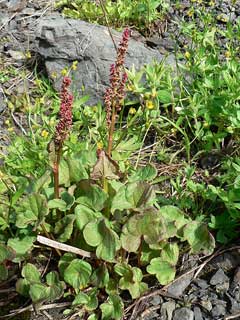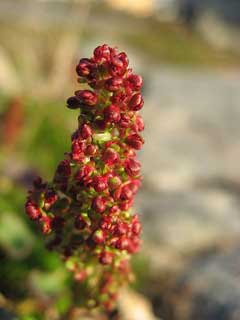 |
|
http://commons.wikimedia.org/wiki/User:Wsiegmund |
 |
| http://commons.wikimedia.org/wiki/User:Slaunger |
Translate this page:
Summary
Physical Characteristics

 Oxyria is a PERENNIAL growing to 0.5 m (1ft 8in) by 0.3 m (1ft).
Oxyria is a PERENNIAL growing to 0.5 m (1ft 8in) by 0.3 m (1ft).
See above for USDA hardiness. It is hardy to UK zone 2 and is not frost tender. It is in flower from June to August, and the seeds ripen from July to August. The species is hermaphrodite (has both male and female organs) and is pollinated by Wind.
Suitable for: light (sandy), medium (loamy) and heavy (clay) soils and prefers well-drained soil. Suitable pH: mildly acid, neutral and basic (mildly alkaline) soils. It can grow in semi-shade (light woodland) or no shade. It prefers moist soil.
UK Hardiness Map
US Hardiness Map
Synonyms
Rheum digynum.
Plant Habitats
Edible Uses
Leaves - raw or cooked[2, 46, 62, 85, 257]. A pleasing acid taste[183] and an excellent potherb[1]. A very nice addition to salads[K]. The leaves can be fermented into a sauerkraut for winter use[183]. Use in moderation, see notes at top of sheet,
References More on Edible Uses
Medicinal Uses
Plants For A Future can not take any responsibility for any adverse effects from the use of plants. Always seek advice from a professional before using a plant medicinally.
The leaves are rich in vitamin C and are used to treat scurvy[212]. The roots, stems and leaves are cooked and eaten in the treatment of dysentery[272].
References More on Medicinal Uses
The Bookshop: Edible Plant Books
Our Latest books on Perennial Plants For Food Forests and Permaculture Gardens in paperback or digital formats.

Edible Tropical Plants
Food Forest Plants for Hotter Conditions: 250+ Plants For Tropical Food Forests & Permaculture Gardens.
More

Edible Temperate Plants
Plants for Your Food Forest: 500 Plants for Temperate Food Forests & Permaculture Gardens.
More

More Books
PFAF have eight books available in paperback and digital formats. Browse the shop for more information.
Shop Now
Other Uses
References More on Other Uses
Cultivation details
Prefers a moist well-drained rocky soil in a sunny position or partial shade[200]. Requires a lime free soil[200]. There is some controversy here since the plant is said to avoid acid soils in the wild[K]. For polyculture design as well as the above-ground architecture (form - tree, shrub etc. and size shown above) information on the habit and root pattern is also useful and given here if available. The plant growth habit is a clumper with limited spread [1-2]. The root pattern is rhizomatous with underground stems sending roots and shoots along their length [1-2].
References Carbon Farming Information and Carbon Sequestration Information
Temperature Converter
Type a value in the Celsius field to convert the value to Fahrenheit:
Fahrenheit:
The PFAF Bookshop
Plants For A Future have a number of books available in paperback and digital form. Book titles include Edible Plants, Edible Perennials, Edible Trees,Edible Shrubs, Woodland Gardening, and Temperate Food Forest Plants. Our new book is Food Forest Plants For Hotter Conditions (Tropical and Sub-Tropical).
Shop Now
Plant Propagation
Seed - sow spring in a cold frame and only just cover the seed. The seed germinates within 2 weeks. It can also be sown as soon as it is ripe, when it germinates within a few days. Prick the seedlings out into individual pots as soon as they are ripe and plant them out into their permanent positions in early summer. Division in the spring. Larger divisions can be planted out direct into their permanent positions. We have found that it is better to pot up the smaller divisions and grow them on in light shade in a cold frame until they are well established before planting them out in late spring or early summer.
Other Names
If available other names are mentioned here
Native Range
TEMPERATE ASIA: China, Eastern Siberia, Far East, Iran, Japan, Jilin Sheng, Kazakhstan, Korea, Kyrgyzstan, Lebanon, Liaoning Sheng, Mongolia, Qinghai Sheng, Russian Federation-Eastern Siberia, Russian Federation-Far East, Russian Federation-Western Siberia, Shaanxi Sheng, Sichuan Sheng, Syria, Tajikistan, Western Siberia, Xinjiang Uygur Zizhiqu, Xizang Zizhiqu, Yunnan Sheng,Afghanistan. TROPICAL ASIA: Bhutan, India, Nepal, Pakistan, NORTHERN AMERICA: Canada, Northwest Territories, Yukon, Québec, Nova Scotia, Newfoundland and Labrador, Alberta, British Columbia, Greenland, United States, Alaska, New Hampshire, South Dakota, Colorado, Idaho, Montana, Oregon, Washington, Wyoming, New Mexico, Arizona, California, Nevada, Utah, EUROPE: Finland, United Kingdom (U.K.), Ireland, Iceland, Norway, Svalbard and Jan Mayen, Austria, Switzerland, Germany, Poland, Slovakia, Russian Federation-European part, European part (Arctic), Latvia, Albania, Bulgaria, Bosnia and Herzegovina, Greece, Italy, Montenegro, Serbia, France,
Weed Potential
Right plant wrong place. We are currently updating this section.
Please note that a plant may be invasive in one area but may not in your area so it's worth checking.
Conservation Status
IUCN Red List of Threatened Plants Status :

Growth: S = slow M = medium F = fast. Soil: L = light (sandy) M = medium H = heavy (clay). pH: A = acid N = neutral B = basic (alkaline). Shade: F = full shade S = semi-shade N = no shade. Moisture: D = dry M = Moist We = wet Wa = water.
Now available:
Food Forest Plants for Mediterranean Conditions
350+ Perennial Plants For Mediterranean and Drier Food Forests and Permaculture Gardens.
[Paperback and eBook]
This is the third in Plants For A Future's series of plant guides for food forests tailored to
specific climate zones. Following volumes on temperate and tropical ecosystems, this book focuses
on species suited to Mediterranean conditions—regions with hot, dry summers and cool, wet winters,
often facing the added challenge of climate change.
Read More
Expert comment
Author
(L.)Hill.
Botanical References
17200
Links / References
For a list of references used on this page please go here
Readers comment
| Add a comment |
|
If you have important information about this plant that may help other users please add a comment or link below. Only comments or links that are felt to be directly relevant to a plant will be included. If you think a comment/link or information contained on this page is inaccurate or misleading we would welcome your feedback at [email protected]. If you have questions about a plant please use the Forum on this website as we do not have the resources to answer questions ourselves.
* Please note: the comments by website users are not necessarily those held by PFAF and may give misleading or inaccurate information.
To leave a comment please Register or login here All comments need to be approved so will not appear immediately.
|
|